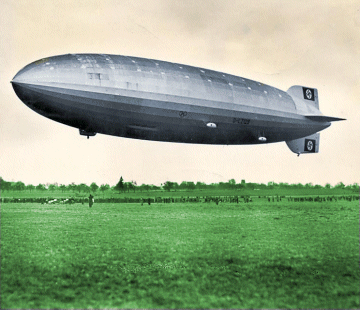Crazy Days
The First Commercial Airline
The First Commercial Airline
DELAG, German: Deutsche Luftschiffahrts-Aktiengesellschaft (German acronym for "German Airship Travel Corporation") was the world's first airline to use an aircraft (a Zeppelin) in revenue service. It was founded on 16 November 1909 with government assistance, and operated airships manufactured by Zeppelin Corporation. Its headquarters were in Frankfurt.
Alfred Colsman served as the airline's first general director. Also involved in the early stages were Dr. Love and Dr. Franz Adickes, the mayor of Frankfurt. The founding capital amounted to three million Marks, of which the majority (Mk 2,600,000) came from the cities of Frankfurt and Düsseldorf. The remaining Mk 400,000 came in the form of airships from the Zeppelin plant in Friedrichshafen.
 Demonstration flight of post-DELAG airship LZ 129 before it received the name Hindenburg, 1936.
Demonstration flight of post-DELAG airship LZ 129 before it received the name Hindenburg, 1936.Passenger service aboard the airship LZ 7 began in 1910 with routes from Frankfurt to Baden-Baden and Düsseldorf. This vessel, known as the "Deutschland", was destroyed on 28 June 1910, nine days after its maiden voyage, when it crashed into the Teutoburger forest. One year later, a steward was introduced aboard the new airship LZ 10 "Schwaben" and was responsible for the well-being of the passengers.
By 1913, DELAG had established a route network between Frankfurt, Düsseldorf, Baden-Oos, Berlin-Johannisthal, Gotha, Hamburg, Dresden and Leipzig. World War I prevented the planned expansion to other European capitals.
By July 1914, one month before the start of World War I, DELAG's Zeppelins had transported 34,028 passengers on 1,588 commercial flights; the fleet had flown 172,535 kilometres in 3,176 hours.
The airships LZ 11, LZ 13, and LZ 17 were pressed into service for the German Army. After the war, however, DELAG's LZ 120 "Bodensee" and LZ 121 "Nordstern" helped reconnect the cities of Europe. LZ 120 already flew between Friedrichshafen and Berlin-Staaken with a stopover in Munich, but both ships were surrendered as post-war reparations in 1921: LZ 120 went to Italy and was re-christened "Esperia", while LZ 121 became France's "Méditerranée" before it ever entered service for DELAG.
In September 1928, DELAG began operating the successful rigid airship LZ 127 Graf Zeppelin. This craft made regular, nonstop, transatlantic flights possible before airplanes had flight ranges sufficient to cross the ocean in either direction without stopping.
The Graf Zeppelin was the final airship employed by DELAG. In 1935, the state-sponsored Deutsche Zeppelin-Reederei (DZR) was founded. Its fleet included the LZ 127 Graf Zeppelin, LZ 129 Hindenburg and LZ 130 Graf Zeppelin.
In 2001, a modern firm also by the name Deutsche Zeppelin Reederei was established as a subsidy of Zeppelin Luftschifftechnik GmbH (ZLT). It operates the Zeppelin NT07 Baden Wurttemberg airship on sightseeing flights around Germany.
DELAG airships in service prior to World War I:
- LZ 6
- LZ 7 Deutschland
- LZ 8 Deutschland (replaced LZ 7)
- LZ 10 Schwaben
- LZ 11 Viktoria Luise
- LZ 13 Hansa
- LZ 17 Sachsen
DELAG airships in service following World War I:
- LZ 120 Bodensee
- LZ 121 Nordstern (North Star)
- LZ 127 Graf Zeppelin, the last airship used by DELAG
In March 1935 the LZ 127 was transferred to the newly founded Deutsche Zeppelin-Reederei company, which also received as start capital the Hindenburg still under construction.